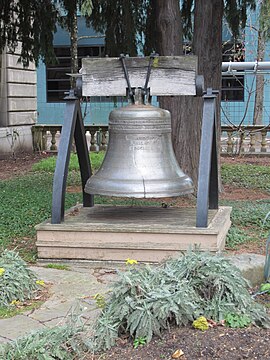
The Quest, sometimes referred to as Saturday Night at the Y or Three Groins in a Fountain, is an outdoor marble sculpture and fountain designed by Count Alexander von Svoboda, located in Portland, Oregon in the United States. The sculpture, carved in Italy from a single 200-ton block of white Pentelic marble quarried in Greece, was commissioned by Georgia-Pacific in 1967 and installed in front of the Standard Insurance Center in 1970. It depicts five nude figures, including three females, one male and one child. According to the artist, the subjects represent man's eternal search for brotherhood and enlightenment.

Fountain for Company H, also known as Second Oregon Company Volunteers, is a 1914 fountain and war memorial designed by John H. Beaver, installed in Portland, Oregon's Plaza Blocks, in the United States. Dedicated to the men of Company H of the 2nd Oregon Volunteer Infantry Regiment killed in service during the Spanish–American War, the limestone and bronze memorial was installed in Lownsdale Square in 1914. It is part of the City of Portland and Multnomah County Public Art Collection courtesy of the Regional Arts & Culture Council. The memorial has been included in published walking tours of Portland.

Running Horses is an outdoor 1986 bronze sculpture by Tom Hardy, located on the Transit Mall in downtown Portland, Oregon. It is part of the City of Portland and Multnomah County Public Art Collection courtesy of the Regional Arts & Culture Council.
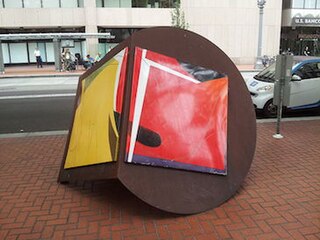
Untitled is an outdoor 1977 steel and porcelain enamel sculpture by American artist John Killmaster, located in downtown Portland, Oregon. It is part of the City of Portland and Multnomah County Public Art Collection courtesy of the Regional Arts & Culture Council.

Royal Rosarian is an outdoor 2011 bronze sculpture by American artist Bill Bane, located at the International Rose Test Garden, Washington Park in Portland, Oregon, United States.

Vera Katz, also known as Mayor, Vera Katz, is an outdoor bronze sculpture depicting Vera Katz created by American artist Bill Bane. Unveiled in 2006, it is located along the Eastbank Esplanade in Portland, Oregon. Katz, a former mayor of the city between 1993 and 2005, supported arts and culture during her tenure and established Oregon's Percent for Art program. She was also instrumental in developing the Eastbank Esplanade, which is named after her. The sculpture has received a mostly positive reception and has inspired people to adorn it with clothing, flowers and makeup.

Untitled is an outdoor 1977 painted aluminum sculpture by Ivan Morrison, located at Southwest 5th Avenue and Southwest Oak Street in the Transit Mall of Portland, Oregon.

The Chiming Fountain, also known as Cupid's Fountain, the John Staehli Fountain, Portland's City Park Fountain and Washington Park Fountain, is an outdoor cast iron fountain and sculpture built in 1891 by John "Hans" Staehli. It is installed in Washington Park in Portland, Oregon, United States. The fountain's name derives from the sound made when water drips from the upper basin. Staehli designed the fountain to serve as a watering trough for horses pulling carriages into the park. Based on a Renaissance fountain, it was originally painted white and included a statuette of a boy, possibly depicting Cupid, though the figure was damaged and permanently removed from the sculpture before or during the 1940s.
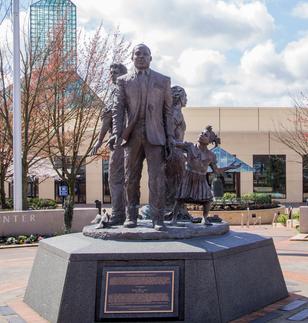
The Dream, also known as the Dr. Martin Luther King Jr. Memorial Sculpture, is an outdoor bronze sculpture of Martin Luther King Jr. by Michael Florin Dente, located outside the Oregon Convention Center in Portland, Oregon. The 8-foot (2.4 m) memorial statue was dedicated on August 28, 1998, the 35th anniversary of King's "I Have a Dream" speech. It depicts King plus three allegorical sculptures: a man who symbolizes the American worker, a woman who represents immigration, and a young girl shown releasing King's coattail, who represents, according to Dente, the "letting go" that occurs when people sacrifice their time and energy to engage in a struggle. The sculpture is part of the City of Portland and Multnomah County Public Art Collection, courtesy of the Regional Arts & Culture Council.

Ring of Time, also known as The Ring of Time, is an outdoor bronze sculpture by Hilda Grossman Morris, located at the entrance to the Standard Plaza in Portland, Oregon. The allegorical sculpture was created during 1965–1967 and is owned by the Standard Insurance Company.

Farewell to Orpheus is an outdoor 1968–1973 bronze sculpture and fountain by Frederic Littman, installed at the Portland State University campus in Portland, Oregon, United States.
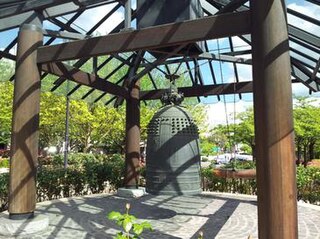
Bell Circles II, also known as Sapporo Friendship Bell and part of the sound installation by composer Robert Coburn called Bell and Wind Environment, is an outdoor bronze bell by an unknown Japanese artist, housed in a brick and granite pagoda outside the Oregon Convention Center in Portland, Oregon, United States. The temple bell was presented by the people of Portland's sister city Sapporo, Japan and dedicated in February 1990. It cost $59,000 and was funded through the Convention Center's One Percent for Art program and by private donors. According to the Smithsonian Institution, some residents raised concerns about the bell's religious symbolism and its placement outside a public building. It was surveyed and considered "treatment needed" by the Smithsonian's "Save Outdoor Sculpture!" program in July 1993.
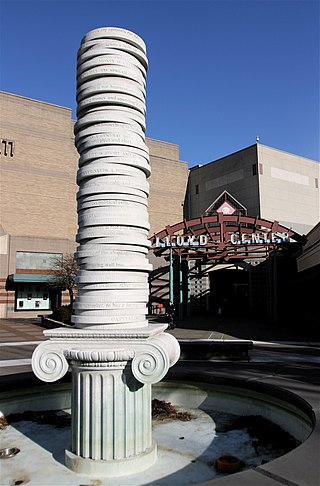
Capitalism is a 1991 outdoor marble and concrete sculpture and fountain by Larry Kirkland, located in northeast Portland, Oregon, United States.
Soaring Stones, also known as Rouse Rocks, Soaring Rocks, and Stones on Sticks, is a 1990 granite-and-steel sculpture by John T. Young. It was first installed in the Transit Mall of Portland, Oregon, and was later sited as Soaring Stones #4 at Whitman College in Walla Walla, Washington. The sculpture was commissioned for $100,000 to replace a fountain that was removed during construction of Pioneer Place.

Host Analog is an outdoor 1991 sculpture by Buster Simpson located outside the Oregon Convention Center in Portland, Oregon, United States.

Daddy Long Legs is an outdoor 2006 painted aluminum sculpture by Mel Katz, located in Portland, Oregon, United States. It is maintained by the Regional Arts & Culture Council.
Unfolding Rhythms is an outdoor 1987 sculpture by Manuel Izquierdo, located in Portland, Oregon, United States.

Korean Temple Bell, part of the sound installation by composer Robert Coburn called Bell and Wind Environment, is an outdoor bronze bell by an unknown Korean artist, housed in a brick and granite pagoda outside the Oregon Convention Center in Portland, Oregon, United States.

The John Fitzgerald Kennedy Memorial, also known as The Grotto: John Fitzgerald Kennedy Memorial, is an outdoor 1965 large bas-relief sculpture and memorial to John F. Kennedy by an unknown artist, installed outside The Grotto in Portland, Oregon, United States.

Salmon Cycle Marker is a 2005 sculpture by Ken MacKintosh and Lillian Pitt, installed outside Portland State University's Native American Student and Community Center, in the U.S. state of Oregon.
